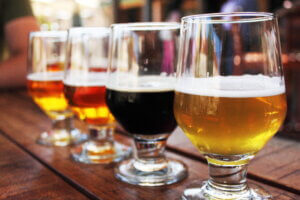By Tracey E. Lesser, Professor of Chemistry and Program Coordinator for Environmental Science and Sustainable Agriculture
 When I tell people I teach Chemistry, the most common responses are, “I’m not good at math,” and “I’m not good at science,” quickly followed by, “I could never do that. Chemistry was hard and I hated it.” And unfortunately, this can be true. It’s all in the pedagogy, or the way in which the subject is taught.
When I tell people I teach Chemistry, the most common responses are, “I’m not good at math,” and “I’m not good at science,” quickly followed by, “I could never do that. Chemistry was hard and I hated it.” And unfortunately, this can be true. It’s all in the pedagogy, or the way in which the subject is taught.
Science learning should be accessible and interesting, but I found non-science students struggling in their science electives. This was three years ago, and I knew then that the traditional Chemistry pedagogy would have to change if I were to teach these students to truly appreciate the subject as much as I do. I needed to create a college-level, high-standards course that left my students saying, “Chemistry really is interesting! It applies to everything in my daily life.” It was quite the challenge.
For my solution, I turned to one of my hobbies: designing and brewing beer. If I could appeal to students using something I love, then perhaps I could spark the same interest in them. Thus began “The Science of Brewing*.” The challenge was making this a relevant, hands-on course that met the college-level standards for a non-science major.
The first step in changing my pedagogy was deciding which science skills the educated citizen needed. This led me to fundamentally shift the way I teach: No more 90-minute lectures and traditional exams and papers; this course’s outcomes would be assessed through hands-on activities, role-playing games, speeches, journals, and a brewing competition.
“The Science of Brewing” starts with a 2-hour interactive lesson on how to taste and smell. We work our way from individual odor compounds in different beer styles through essential oils and extracts to the five most common beer styles. Through this master-led exercise, I work with students to show them how to detect individual odor and taste components. After learning how chemical receptors in our taste buds work, the students write out the tasting profile and identify the compounds presents in 31 different beers over the course of the semester.
But it’s not all about tasting beer. Any good non-major science course needs history and context lessons to illustrate the real-world applications of science. To accomplish this goal, I’ve incorporated the role-playing game, “London 1854: Cesspits, Cholera and Conflict over the Broadstreet Pump,” published by Columbia University’s Barnard College. This allows me to bring the students into the history with ties to microbiology, chemistry and brewing process. They learn about the historical event, write speeches, and argue policy and science as it was understood in 1854. The students then write a paper explaining what modern science tells us about each of these ideas and discoveries.
A large part of the class – up to 65% – is experimentation. The students design and brew beer for public NHTI events, where they get evaluated and receive public feedback.
With this change in pedagogy, I’ve found that, when comparing similar test questions among Chemistry courses, non-science majors in this brewing course do better than average on understanding common Chemistry concepts than non-science majors in a traditional chemistry course. As with many science courses for non-majors, the struggle is getting students to come, stay engaged and turn in the work, but the students that do are rewarded.
The past 3 years has taught me that students in a hands-on, project-based learning course are more likely to complete it with earned credit than the non-majors in more traditional science courses.
*This class is available for students aged 21 and older only.
Read More:

